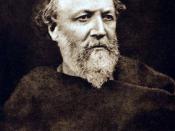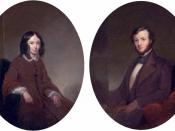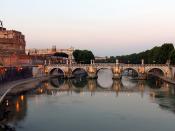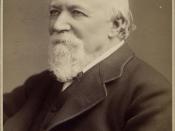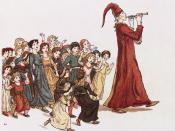Robert Browning lived and wrote during a time of radical changes. England was becoming a large city and the Origin of Species of Darwin had made a lot of people question the old bases of morality. The increasing wealth, product of the industrial revolution, boiled down to consumerism and materialism. Although many people became wealthy many more were in deep poverty. Robert Browning explored these issues in his poetry. "Love Among the ruins," for instance, criticizes the morality of a city of magnificence and superposes the endurance of love over it.
The poem has a very witty structure. It is made of seven stanzas. Each stanza is made of six couplets and each couplet is made of long iambic lines that alternate with short three syllabus ones. The short lines not only rhyme rounding up the couplet but also point up or emphasize the idea started in the previous line.
The rhythmic fluently provided by the very ingenious rhymes make this poem easy to remember and pleasant to read. This made the content of the poem easy to deliver in the readers' mind.
Browning contrast past and present images all along the poem. The first lines, for instance, set a beautiful rural image of the horizon when the sun is setting, full of color with the last rays of day's light. "Where the quiet-colored end of evening smiles, / Miles and miles..." (1-2) then the set becomes pleasantly calm and peaceful. "On the solitary pastures where our sheep / half asleep / Tinkle homeward⦠(3-5). All this peacefulness contrasts with the noise of a crowded disappeared city "great and gay" (7) that once stood at the same place where now nature has taken over. "The contrast between past and present, which is the core of the poem, is reinforced by devoting one half of each stanza to the past and the other half to the present." (Abrams: 1365)In the second and third stanza, the poet emphasizes the description of the disappeared city as magnificent, and contrasts it with the simplicity of nature that prevails. In line (13), nature "does not even boast a three" where a powerful and strong city had a "domed and daring palace that shot its spires / up like fires" (19-20). Moreover, the first couplet of the third stanza powerfully reduces such city to a carpet of grass. "And such plenty and perfection, see, of grass / Never was!" (25-6)Also in the third stanza the poet criticizes the society of the city in a moral religious context. "Men breathed joy and woeâ¦" (31). People who lived in sin could only find superficial satisfaction and pleasure in their pursuit for glory and wealth but that pleasure was equally experienced as woe.
"Lust of glory pricked their hearts, dread of shameStruck them tame;And that glory and that shame alike, the goldBought and sold." (33-6)These two last couplets of the third stanza evoke the deadly sins of lust and greed and how they corrupted the hearts of men in large cities and empires such as Rome and United Kingdome.
Even though it is not specified, there are several references that point Rome to be the city in "Love Among the Ruins." The poem begins with an image of a sunset in the horizon; this image is commonly seen in areas near the ocean, the Mediterranean Sea for instance. "The poem's setting presumably is Italian." (Bloom: 1293) In the second stanza, the description of the city fits the main characteristics of one of the most important building of the ancient Rome, The Pantheon.
"Where the domed and daring palace shot its spiresUp like firesO'er the hundred-gated circuits of a wallBounding all,Made of marble⦠(19-23)The Pantheon was built by Marcus Agrippa in 27 BC, it had a dome that symbolizes the vault of heaven and was mainly made of marble. In the fourth stanza, the poem mentions capers which are a native plant of the Mediterranean area. "By the caper overrooted, by the ground."(39)Also from the fourth stanza, monarchs in Rome used to organize chariot races for their amusement.
"And a burning ring, all round, the chariots tracedAs the race,And the monarch and his minions and his damesViewed the games" (45-8)Finally in the sixth stanza there are undeniable elements that point Rome; such as temples on top of hills, colonnades, bridges and aqueducts.
"All the mountains topped with temples, all the glades'Colonnades,All the causeys, bridges, aqueducts,-and then,All the men! (63-6)Bridges and aqueducts and a combination of both were as important as common in the Roman Empire.
The use of colors provides different effects in the poem. The introductory image of a colorful sunset in the first stanza changes into a scene where colors are fading "quite-coloured eve / smile to leave" (49-50) and the landscape is turning rather grey. "And the slopes and rills in undistinguished grey / Melt away." (53-4) This change of color evokes the course of time as the poem goes by for the sun is setting. It also sets an opaque environment to emphasize the introduction of a girl with "yellow" hair; a color that connotes brilliance and majesty. "A girl with eager eyes and yellow hair / waits me there." (55-6) the poem consolidates the importance of the lady by placing her as an equal with a king in a juxtaposed image. "When the king looked, where she looks now, breathless, dumb / Till I come." (59-60)Furthermore, the poet contrasts the image of the lovers when they meet with that of the great city; This image in the last couplet of the fifth stanza continues in the sixth one by describing what both the king and the lady see. On the one hand the king sees his kingdom "But he looked upon the city, every side / far and wide" (61-2) while on the other hand the lady is careless about the surroundings and only is waiting anxiously for his beloved one.
"When I do come, she will speak not, she will stand,Either handOn my shoulder, give her eyes the first embraceOf my face, (67-70)The last couplet of the sixth stanza draws an image of a passionate encounter that supposes the act of sex as the consummation of love. "Ere we rush, ere we extinguish sight and speech / each on each (71-2). The title of the poem can be resumed in this stanza. In the ruins of a great city that long time ago was "great and gay," (7) two lonely lovers enjoy love.
Adding to the critical context, the poem ridicules and condemns the pagan city and superposes love over it. In the seventh and final stanza, the poet brings up the impressive achievements that millions of warriors had and the way they praised their deities. "And they built their gods a brazen pillar high / As the sky." Moreover, he remarks their great richness. "Yet reserved a thousand chariots in full force- / Gold, of course," (77-8) but just then, as if he were a priest, he condemns such achievements.
"Oh heart! Oh blood that freezes, blood that burns!Earth's returnsFor whole centuries of folly, noise, and sin!Shut them in, (79-82)The exclamation signs not only evoke energetic disapproval, but also rejection towards the antique civilization, which is rounded with at the end of line 83; "the rest." The last lines of condemnation set up for the final and forceful closing statement. "Love is best" (84)By contrasting past and present images, Robert Browning compares material glory with the endurance of love. Such images of the past suit well the city where he lived. Therefore, by criticizing the ancient city in his poem, he also criticized London without being moralistic or overly strident. However, the most attractive issue in "Love Among the Ruins" is how well crafted it is.
Bibliography:Abrams, M.H. and Stephen Greenlatt, ed. The Northon Anthology of English Literature. 7th ed. Vol. II. New York: W.W. Norton, 2000Bloom, Harold, Martin Price et al. The Oxford Anthology of English Literature. Vol. II. New York: Oxford University Press, 1973Browning, Robert. "Love Among the Ruins." The Oxford Anthology of English Literature. Bloom, Harold, Martin Price et al.ed. Vol. II. New York: Oxford University Press, 1973
